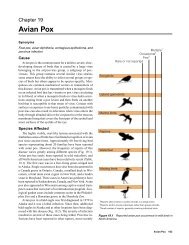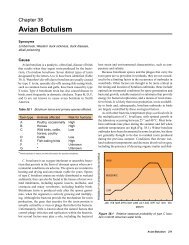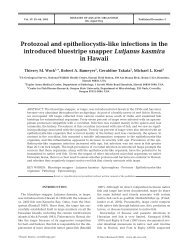Organophosphorus and carbamate pesticides - National Wildlife ...
Organophosphorus and carbamate pesticides - National Wildlife ...
Organophosphorus and carbamate pesticides - National Wildlife ...
You also want an ePaper? Increase the reach of your titles
YUMPU automatically turns print PDFs into web optimized ePapers that Google loves.
Figure 39.7 Hemorrhage in the intestine is an occasional<br />
finding in waterfowl that died of exposure to <strong>pesticides</strong>, particularly<br />
organophosphorus compounds.<br />
Followup to wildlife mortality incidents due to pesticide<br />
poisoning is important for determining the source <strong>and</strong> the<br />
use of a chemical. Documented wildlife mortality from approved<br />
pesticide applications is considered by regulatory<br />
authorities for developing label use restrictions <strong>and</strong> for<br />
licensing pesticide formulations. Malicious use of <strong>pesticides</strong><br />
to kill unwanted wildlife is against the law, <strong>and</strong> legal means<br />
can be employed to stop illegal use.<br />
Persons who apply <strong>pesticides</strong> need to consider wildlife<br />
use <strong>and</strong> environmental conditions when they apply the chemicals.<br />
Migration patterns of the wildlife that use the area, the<br />
presence of nesting <strong>and</strong> breeding species, <strong>and</strong> weather conditions,<br />
such as the potential for aerial drift or runoff into<br />
wetl<strong>and</strong>s or ponds, are among the factors that should be considered.<br />
Pesticides should be applied only as directed; the<br />
use of alternate chemicals or formulations that pose less risk<br />
to nontarget species should also be considered. Buffer zones<br />
at crop perimeters will provide more protection to areas used<br />
by wildlife. Agricultural l<strong>and</strong> planted adjacent to wetl<strong>and</strong>s<br />
should be plowed parallel to a wetl<strong>and</strong> to minimize runoff.<br />
Human Health Considerations<br />
Human exposure to OP or <strong>carbamate</strong> <strong>pesticides</strong> can result<br />
in serious illness or even death. Exposure can occur<br />
through inhalation, absorption through the skin, or by ingestion.<br />
When <strong>pesticides</strong> that may be associated with wildlife<br />
mortality incidents are investigated, field procedures should<br />
be scrutinized to avoid inadvertent exposure of personnel to<br />
<strong>pesticides</strong>. Persons who collect carcasses or field samples<br />
must prevent their exposure by wearing nonpermeable gloves,<br />
rubber boots, or other appropriate clothing that will prevent<br />
skin absorption, <strong>and</strong> respirators should be used if chemical<br />
inhalation is possible.<br />
Poisoning in humans should be treated as a serious medical<br />
emergency. When someone seeks medical attention for<br />
exposure to an OP or <strong>carbamate</strong> compound, the attending<br />
Photo by Paul Soler<br />
physician should be informed that the person may have been<br />
exposed to these chemicals. Patients can be monitored by<br />
blood sampling to evaluate their blood ChE levels. Aggressive<br />
treatment of acute intoxication does not protect against<br />
the possibility of delayed onset neurotoxicity or persistent<br />
neurological defects. Certain compounds have been documented<br />
to cause delayed effects in humans. An intermediate<br />
syndrome that occurs within 24–96 hours after exposure has<br />
recently been described with intoxications of fenthion,<br />
dimethoate, monocrotophos, <strong>and</strong> methamidophos. Muscles<br />
of the limbs <strong>and</strong> those innervated by cranial nerves are affected,<br />
causing palsies, respiratory depression, <strong>and</strong> distress.<br />
Another delayed neurotoxicity from some OP compounds<br />
can occur 1–2 weeks after exposure. Initially, incoordination<br />
develops, <strong>and</strong> it can progress to moderate to severe<br />
muscle weakness <strong>and</strong> paralysis. This delayed effect was<br />
documented with some OP compounds that were rarely used<br />
as <strong>pesticides</strong>, but the effect may be a potential risk with similar<br />
compounds that are more commonly used today if sufficient<br />
exposure to the compound occurs. These delayed effects<br />
could be a problem in wildlife, but they have not been<br />
recognized yet in any wildlife species.<br />
Linda C. Glaser<br />
Supplementary Reading<br />
Amdur, M.O., Doull, J., <strong>and</strong> Klaassen, D.C., eds., 1991, Casarett<br />
<strong>and</strong> Doull's Toxicology, The basic science of poisons, (4th<br />
ed.): Elmsford, N.Y., Pergamon Press, 1,033 p.<br />
Grue, C.E., Fleming, W.J., Busby, D.G., <strong>and</strong> Hill, E.F., 1983,<br />
Assessing hazards of organophosphate <strong>pesticides</strong> in wildlife,<br />
in Transactions of the 48th North American <strong>Wildlife</strong> &<br />
Natural Resources Conference: Washington, D.C., The<br />
<strong>Wildlife</strong> Management Institute, p 200–220.<br />
Hill, E.F. <strong>and</strong> Fleming, W.J., 1982, Anticholinesterase poisoning<br />
of birds: field monitoring <strong>and</strong> diagnosis of acute poisoning:<br />
Environmental Toxicology <strong>and</strong> Chemistry 1:27–38.<br />
Hill, E.F., 1995, <strong>Organophosphorus</strong> <strong>and</strong> <strong>carbamate</strong> <strong>pesticides</strong>, in<br />
Hoffman, D.H., Rattner, B.A., Burton, G.A., Jr., <strong>and</strong> Cairns,<br />
J., Jr., eds., H<strong>and</strong>book of ecotoxicology: Boca Raton, Fla.,<br />
Lewis Publishers, p 243–274.<br />
Mineau, P., ed., 1991, Cholinesterase-inhibiting Insecticides,<br />
Their impact on wildlife <strong>and</strong> the environment, chemicals in<br />
agriculture v. 2.: Amsterdam, The Netherl<strong>and</strong>s, Elsevier<br />
Science Publishing, 348 p.<br />
Smith, G.J., 1987, Pesticide use <strong>and</strong> toxicology in relation to<br />
wildlife: <strong>Organophosphorus</strong> <strong>and</strong> <strong>carbamate</strong> compounds:<br />
Washington, D.C., U.S. Department of the Interior, Fish <strong>and</strong><br />
<strong>Wildlife</strong> Service, Resource Publication 170, 171 p.<br />
<strong>Organophosphorus</strong> <strong>and</strong> Carbamate Pesticides 293
















